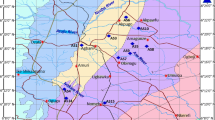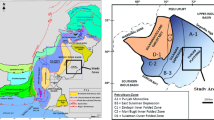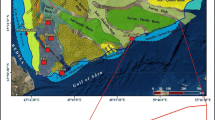Abstract
In this study, kerogen samples, including 19 from northwestern Taiwan, 15 from China, and 16 from Australia were analyzed, and integrated with 49 published data, to explore the significance of atomic H/C ratio as a parameter of source rock evaluation. Organic matters in the samples studied are of type II/III kerogen based on the relationship between HI and T max. The H/C ratio, as well as the HI, S1, and S2, generally decreases with the maturity increasing. The H/C ratio decreases slightly from 1.1 to 0.7 with the maturity increasing from Ro 0.55 to 0.85 %. Samples with H/C ratio in this range show significant change in certain other geochemical parameters (e.g., HI, S1, S2, S1 + S2, S1/(S1 + S2), S1/TOC, (S1 + S2)/TOC, T max). The atomic H/C value is in the range of 0.7–1.1, the value of the corresponding HI shows a stable increasing trend. This shows that organic matters in an oil window of Ro% = 0.55 and atomic H/C = 1.1 have reached a certain maturity and hydrocarbon potential. The QI, HI and H/C ratio shows a certain correlation, all increasing accordingly. It is inferred that hydrocarbon potential started from Ro 0.55 % and atomic H/C ratio 1.1 in this study.















Similar content being viewed by others
References
Akinlua A, Ajay TR, Jarvie DM, Adeleke BB (2005) A re-appraisal of the application of Rock-Eval pyrolysis to source rock studies in the Niger Delta. J Pet Geol 28(1):39–48
ASTM (1975) Standard D-2797, ASTM Standard manual, Part 26, pp 350-354
ASTM (1980) Standard D-2797, Microscopical determination of volume percent of physical components in a polished specimen of coal. ASTM, Philadelphia
Baskin DK (1997) Atomic H/C ratio of kerogen as an estimate of thermal maturity and organic matter conversion. AAPG Bulletin 81(9):1437–1450
Bostick NH (1971) Thermal alteration of clastic organic particles as a indicator of contact and burical metamorphism in sedimentary rocks. Geosci Man 3:83–93
Bostick NH (1974) Phytoclasts as Indicator of thermal metamorphism, Franciscan Assemblage and Great Vally Sequence (upper Mosozoic), California. Spec Pap Geol Soc Amer 153:1–17
Bustin RM (1991) Quantifying macerals: some statistical and practical considerations. Int J Coal Geol 17:213–238
Chiu H-T (1975) Miocene stratigraphy and its relation to the Paleogene rocks in western-central Taiwan. Petro Geol Taiwan 12:51–80
Dahl B, Bojesen-Koefoed J, Holm A, Justwan H, Rasmussen E, Thomsen E (2004) A new approach to interpreting Rock-Eval S2 and TOC data for kerogen quality assessment. Org Geochem 35:1461–1477
Dormans HNM, Huntjens FJ, van Krevelen DW (1957) Chemical structure and properties of coal XX-composition of the individual macerals (vitrinites, fusinite, micrinites and exinites). Fuel 36:321–339
Espitalie J, La Porte JL, Madec M, Marquis F, Le Plat P, Paulet J, Boutefeu A (1977) Methode rapide de caracterisation des roches meres de leur potential petrolier et de leur degre d’evolution. Revue l’Inst Francais du Petrole 32(1):23–42
Ge T-S, Chen Y-X, Yu T-X, Wang G-S, Niu Z-R, Shen S-W, Li Y-L, Song S-Y, Wu T-S, Zhao Q-B, Xiong C-Y (1993) Liaohe Oil Field. Petrol Geol China 3:474–494
Hunt JM (1996) Petroleum geochemistry and geology, 2nd edn. W. T. Freeman and Company, New York, p 734
Lee H-T, Tsai LL, Sun L-C (2010) Relationships among geochemical indices of coal and carbonaceous materials and implication for hydrocarbon potential evaluation. Environ Earth Sci 60:559–572
Li S, Pang X, Li M, Jin Z (2003) Geochemistry of petroleum systems in the Niuzhuang South Slope of Bohai Bay Basin—part 1: source rock characterization. Org Geochem 34:389–412
Magoon LB, Dow WG (1994) The petroleum system-from source to trap. AAPG Memoir 60, Tulsa, p 655
Mao EW et al (1988) Depositional environment of the Nanchuang Formation in the Miaoli and Hsinchu area, Taiwan. Petrol Geol Taiwan 24:37–50
Peters KE, Cassa MR (1994) Applied source-rock geochemistry, In: Magoon LB, Dow WG (eds), The petroleum system—from source to trap. American Association of Petroleum Geologists Memoir 60:93–120
Rimmer SM, Cantrell DJ, Gooding PJ (1993) Rock-Eval pyrolysis and vitrinite reflectance trends in the Cleveland Shale member of the Ohio Shale, eastern Kentucky. Org Geochem 20(6):735–745
Smith JR, Smith JW (2007) A relationship between the carbon and hydrogen content of coals and their vitrinite reflectance. Int J Coal Geol 70:79–86
Stach E, Mackowsky M-Th, Teichmüller M, Taylor GH, Chandra D, Teichmüller R (1982) Stach’s Textbook of coal petrology (3rd edn). Gebruder Borntraeger, Berlin, p 535
Su PJ (2001) The influence of maceral composition on Rock-Eval Pyrolysis, Masters Dissertation, Graduate Institute of Applied Geology at National Central University, p 73
Sun LZ (2000) Measurement of vitrinite reflectance suppression- coal sample separation from Yufeng, Taiwan as an example, Ph.D. Dissertation of Institute of Geophysics at National Central University, p 81
Taylor AW, Ritts BD (2004) Mesoscale heterogeneity of fluval-lacustrine reservoir analogues: examples from the Eocene Green River and Colton Formations, Uinta Basin, Utah, USA. J Pet Geol 27:3–26
Ting FTC (1978) Petrographic techniques in coal analysis. In: Karr C Jr (ed) Analytical Methods for Coal and Coal Products. Academic Press, Inc., New York, pp 3–26
Tissot BP, Welte DH (1984) Petroleum formation and occurrence; a New approach to oil gas exploration. Springer-Verlag, Berlin, p 699
Tsai LY (1988) Paragenetic implications of vitrinite in Chilung-Taipei coal fields. J Ti-Chih 8(1–2):63–70
Tsai LL, Hsieh J, Sun L-C, Lee H-T (2004) A hydrocarbon potential study of local petroleum system in NW Taiwan. 32nd IGC Florence 2004-Scientific Sessions: Abstracts (Part 2)-1391
Tsai LL, Yang T-C, Lee H-T, Sun L-C (2005) Characteristics of organic material and thermal maturity in a local petroleum system, 22nd Annual Meeting of The Society for Organic Petrology. Louisville, pp 124-126
Udo OT, Ekweozor CM, Okogun JI (1986) Organic petrographic and programmed pyrolysis studies of sediments from Northwestern Niger delta, Nigeria. J Min Geol 24:85–96
Wang CJ (1998) “Folded-fan” evaluation of coal’s hydrocarbon potential. Geochemistry 27(5):483–492
Xiao X (1997) The organic petrological characteristics of Triassic source rocks and their hydrocarbon-generating potential in Tarim Basin. Geochimica 26(1):64–71
Xiao X, Liu D, Fu J (1996) The evaluation of coal-measure source rocks of coal-bearing basins in China and their hydrocarbon-generating models. Acta Sedimentologica Sincia 14(supp):10–17
Yao S, Xue C, Hu W, Cao J, Zhang C (2006) A comparative study of experiment maturation of peat, brown coal and subbituminous coal: implications for coalification. Int J Coal Geol 66:108–118
Acknowledgments
We wish to thank anonymous reviewers of this manuscript for giving constructive suggestions and revision comments. Special thanks to all of the faculties and staff of the Geochemical Department of Exploration and Development Research Institute, CPC, for providing valuable samples and analyzing assistance. This research was financially supported by Grants NSC-99-2116-M-252-001 and NSC-101-2116-M-252-001 of National Science Council.
Author information
Authors and Affiliations
Corresponding author
Rights and permissions
About this article
Cite this article
Lee, HT., Sun, LC. The atomic H/C ratio of kerogen and its relation to organic geochemical parameters: implications for evaluating hydrocarbon generation of source rock. Carbonates Evaporites 28, 433–445 (2013). https://doi.org/10.1007/s13146-013-0138-5
Accepted:
Published:
Issue Date:
DOI: https://doi.org/10.1007/s13146-013-0138-5




